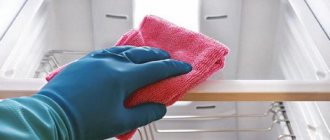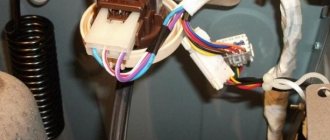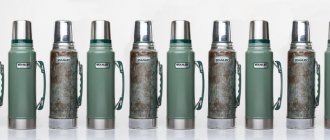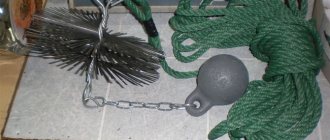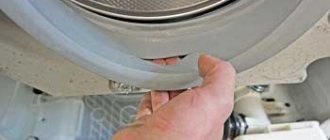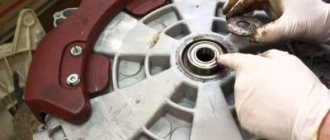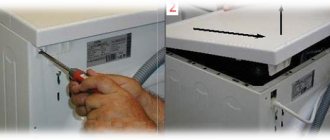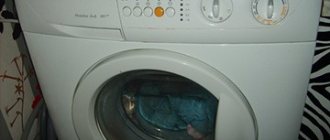The refrigerator is one of the most commonly used household appliances. Over time, various contaminants inevitably appear on its internal and external surfaces that must be removed.
Washing refrigerators equipped with a know frost system has a number of features that must be taken into account when performing the procedure.
How does the system work?
The difference between know frost units and devices with drip defrosting is the absence of a freezing evaporator in their freezer chamber.
The evaporator is a coil-shaped radiator made of aluminum and located behind the rear panel of the freezer.
ATTENTION! In the space between the outer and inner walls of the chamber there are air channels through which cold air is evenly distributed throughout the refrigerator.
At the bottom of the evaporator there is a drainage hole : through it, the moisture generated as a result of thawing of this functional unit goes into a special container near the compressor and evaporates.
The fan (located next to the evaporator) is a plastic impeller or wheel-shaped device that directs cooled air through a system of air ducts to various parts of the chambers.
The heater is a spiral (made of tungsten or nichrome) placed in an aluminum housing or glass flask. The purpose of the unit is to remove frost from the evaporator .
The operating principle of the know frost system:
- when the refrigerator is turned on, the compressor and fan start working, and the air gradually cools;
- When the temperature on the thermostat reaches 10 ⁰С below zero, the timer breaks the “fan-compressor” circuit and closes the “heater-evaporator” circuit, as a result of which the evaporator heats up and the frost melts. Defrosting occurs until the thermostat reaches a temperature of 10 ⁰C. After this, the timer closes the circuit between the fan and compressor again;
- 8 hours after the first defrost, the timer repeats the evaporator defrost cycle again.
Is your refrigerator equipped with the No Frost system?
Not really
Cooling of the chambers occurs as follows:
- warm air from the interior of the refrigerator absorbs the refrigerant passing through the evaporator;
- the substance boils under the influence of elevated temperature and goes into a gaseous state;
- the compressor pumps freon into the condenser, where its temperature drops again and it turns into liquid, which enters the capillary tubes located between the inner and outer walls of the chamber;
- cooled freon again “takes” heat from the refrigerator compartments, turns into steam and enters the evaporator. The cycle repeats.
This publication will tell you about how to properly defrost a Samsung No Frost refrigerator.
Does it need to be defrosted?
The know frost system provides for automatic defrosting of the device . However, many owners of household appliances during their operation are faced with the fact that frost forms in the freezer and sometimes even inside the refrigerator compartment.
Why does this happen? The reason for the formation of ice is non-compliance with the rules for using the refrigerator: overloading the shelves with many pots, bowls of food, placing hot food in it.
ATTENTION! The appearance of a snow “coat” may be associated with a malfunction of the device: failure of the thermostat, damage to the rubber seal on the door, clogging of the capillary tubes.
In addition, the operation of the know-frost system is directly affected by the choice of the correct operating mode of the refrigerator: too low a cooling temperature for the chambers or a constantly turned on super-freezing function leads to freezing of the chambers.
Taking into account the listed factors, it should be said that even such modern devices also require manual defrosting. The frequency of defrosting directly depends on the rate of ice formation; in most cases, the device must be defrosted and washed at least once a year.
If frost is not removed, the heat exchange between the chamber walls and the refrigerant will be disrupted . As a result, the compressor will have to work with more power, which can lead to rapid wear of the functional element and breakdown of the refrigerator.
IMPORTANT! One of the main factors indicating the need for urgent defrosting of the device is the thickness of the formed ice: if the layer of frost on the walls approaches 1 cm, start defrosting.
Read about how to turn on the refrigerator after defrosting.
Do I need to defrost an LG refrigerator with No Frost?
LG refrigerator with No Frost needs to be defrosted once a year
Above we looked at the operating diagram of No-Frost refrigerators. The ice in them defrosts automatically, so nothing can freeze anywhere in properly functioning equipment. We came across No Frost refrigerators that worked properly for 10 years, and they were never unplugged from the outlet, much less defrosted.
All that No Frost requires is periodic wet cleaning. It is enough just to remove crumbs and debris, wipe the walls and shelves of the refrigerator: this will ensure not only a neat internal appearance, but also the absence of an unpleasant odor in the refrigerator compartments. Before cleaning, be sure to unplug the refrigerator.
After cleaning the LG refrigerator with No Frost, you cannot immediately turn it on
This myth has some basis, but it is outdated. “Sofa experts” write that the reason lies in equalizing the pressure in the system. The logic is this. When the compressor is running, the freon in the condenser is under high pressure, and after turning off the motor, the pressure in the system cannot instantly equalize. In particular, increased pressure will remain for some time at the outlet of the compressor (in the discharge tube). The motor is not designed to start under such conditions: the starting torque may not be enough to move the piston against the pressure, so the compressor may jam. Blocking the motor shaft when power is supplied to the compressor, in turn, is considered a dangerous condition, since the motor windings are overloaded and can burn out. Then the compressor will need to be replaced.
If we talk about old refrigerators, then there is indeed a possibility of the situation developing according to such a scenario, which leads to a “wedge” of the motor. But only if you turn it on almost immediately. If you let the refrigerator sit for at least 5-10 minutes (and it is unlikely that wiping will take less time), no problems will arise.
Modern models are even equipped with protective relays: after disconnecting from the power supply, it simply will not allow the engine to start immediately. This way, you can plug in your refrigerator immediately after cleaning. The compressor will only start when the system is ready to start safely.
What cleaning products can be used?
To wash your refrigerator, you can use both chemicals and homemade products.
Dish detergent:
- pour hot water into a bowl, add a couple of teaspoons of washing gel to it, mix the ingredients until foam forms;
- soak a soft sponge in the solution, wipe all elements previously removed from the device (shelves, grilles, drawers) and the internal and external surfaces of the refrigerator;
- After removing dirt, be sure to rinse off any remaining cleaning product with water.
Other chemicals in the form of various sprays, liquids, foam, wet wipes ( Top House, Silit Bang, Horse ) are also suitable for cleaning the refrigerator.
In addition to excellent cleaning properties, which allow housewives to get rid of contaminants in the device in a short time, most of these products also have disinfecting abilities.
IMPORTANT! When working with special preparations, do not forget to wear rubber gloves. After cleaning surfaces, be sure to wipe them with a cloth dampened in clean water.
Traditional methods will also help you rid your refrigerator of stains of various origins:
- make a soda solution from 2 tablespoons of powder and 1 liter of water, treat the inner walls of the chambers with it, rinse the surfaces with water;
- grate half a bar of laundry soap, mix the shavings with warm water. Use the product to remove dirt from problem areas;
- dampen the sponge in hydrogen peroxide (3%) and wash the chambers.
The sealing tape on the door of the device can also be cleaned with dishwashing detergent and hydrogen peroxide.
The use of vinegar, soda to remove mold or grease from a rubber element is unacceptable , since these substances can damage the part and break the seal of the chambers.
If you notice that the tape has lost its elasticity, apply a little olive oil to a rag and rub it into the seal.
IMPORTANT! To clean the refrigerator, do not use aggressive chemicals (containing chlorine, concentrated acids, alkalis) or abrasives. Treat the surfaces of electrical appliances only with soft cloths or sponges.
Where to start cleaning?
Start cleaning the refrigerator only after it has defrosted:
- set the thermostat to position “0”, disconnect the device from the network;
- lay old towels on the floor around the refrigerator, open the door of the device and fix it in this form;
- remove food from the refrigerator and place it in a cool place;
- remove all removable elements (shelves, drawers), wash them in soapy water, rinse and leave to dry;
- remove the moisture formed during the defrosting process and begin washing the device.
IMPORTANT! If both refrigerator compartments are equipped with a know-frost system, you can defrost and wash them either simultaneously or alternately.
Find out more about defrosting a two-compartment Bosch refrigerator. Read about how to defrost a Stinol two-chamber refrigerator here.
Cleaning up the inside of the LG No Frost refrigerator
- When cleaning a household appliance, start by cleaning its internal parts, moving from top to bottom and paying special attention to the corners of the chambers;
- do not forget to wash and disinfect the drain hole on the back wall of the refrigerator compartment: clean it with a brush, then draw detergent into a syringe (without a needle) and pour it into the channel;
- clean the holes on the fan grille with cotton swabs soaked in cleaning product;
- wash the outer parts of the case, wipe the condenser located on the back wall with a slightly damp sponge;
- Wash the sponge or rag from any remaining cleaning products, fill a bowl with water and rinse all surfaces with it;
- take a dry towel and wipe the refrigerator inside and out;
- leave the device with the door open so that all moisture from the internal surfaces completely evaporates;
- Reinstall the shelves and drawers in their original place, plug in the device and after half an hour place the food in it.
IMPORTANT! According to the recommendations of manufacturers of refrigerators with a no-frost system, such units can only be connected to the network 12 hours after being turned off.
How to properly clean up the interior?
- When cleaning a household appliance, start by cleaning its internal parts, moving from top to bottom and paying special attention to the corners of the chambers;
- do not forget to wash and disinfect the drain hole on the back wall of the refrigerator compartment: clean it with a brush, then draw detergent into a syringe (without a needle) and pour it into the channel;
- clean the holes on the fan grille with cotton swabs soaked in cleaning product;
- wash the outer parts of the case, wipe the condenser located on the back wall with a slightly damp sponge;
- Wash the sponge or rag from any remaining cleaning products, fill a bowl with water and rinse all surfaces with it;
- take a dry towel and wipe the refrigerator inside and out;
- leave the device with the door open so that all moisture from the internal surfaces completely evaporates;
- Reinstall the shelves and drawers in their original place, plug in the device and after half an hour place the food in it.
IMPORTANT! According to the recommendations of manufacturers of refrigerators with a no-frost system, such units can only be connected to the network 12 hours after being turned off.
How to clean a No Frost refrigerator
Sequence of defrosting the refrigerator
Despite the presence of the No Frost function, which literally translates as “no frost,” it is recommended to defrost it several times a year. This should be done in combination with general cleaning of the equipment.
Defrosting is a temporary disconnection of a device from the network, since a properly functioning device of a similar type, in this case, defrosts automatically.
Note! Refrigerators accumulate an unpleasant odor. To eliminate the smell, you should completely defrost the unit and give it the opportunity to ventilate.
Defrosting rules:
- Defrosting in extreme heat is excluded;
- In a two-chamber one, defrosting of one of the chambers is allowed;
- If there is only one circuit, before washing the Know Frost refrigerator, you should set the thermostat to o and only then turn off the equipment from the network;
- After switching off, the entire contents of the chambers are removed, the device door remains wide open;
There is a sequence for cleaning a Know Frost refrigerator:
- Washing is carried out completely, including washing the rear surface of the unit;
- Before washing a refrigerator with a no frost system, you need to allow the internal parts of the device to cool to room temperature;
- The ventilation compartments are cleaned using cotton swabs;
- The shelves located on the door and internal elements are cleaned;
- All surfaces are wiped dry;
- Before turning on the equipment, you need to make sure that all surfaces to be wiped are dry.
Attention! Cleaning the back wall of the device is necessary to reduce the energy consumption of the equipment.
How to get rid of unpleasant odors?
The appearance of unpleasant odors in the device is most often associated with improper storage of products (failure to comply with product rules, storage of spoiled food, etc.).
To get rid of the “aroma,” first of all, find out and eliminate the cause of its occurrence.
The following methods will help eliminate strong odors from the refrigerator:
- mix vinegar and water in equal proportions and wash the inner walls of the chamber;
- crush 20-30 tablets of activated carbon, pour it onto plates or into gauze bags, place the product inside the refrigerator;
- crushed citrus peels (lemon, orange), black tea, sugar, rice, vanilla, coffee beans (grind them first) “absorb” various aromas well: as in previous cases, place the products in bags made of linen fabric, gauze, put inside a household devices.
Special refrigerator balls , which are sold in household chemical stores, effectively eliminate even the most pungent odor.
The mineral components they contain destroy the unpleasant “amber” and prevent the appearance of mold. The balls are effective for 3-4 months; after this period, the drugs should be replaced with new ones.
ADVICE! Don't forget to take care of the device if you need to leave for a long time: defrost, wash the device and leave it unplugged, with the door open.
Carry out periodic checks of the products in the unit, throw away food that has expired , store food in special containers closed with a lid.
Cleanliness in the refrigerator is not only the key to your health, but also to the long life of your kitchen appliances.



